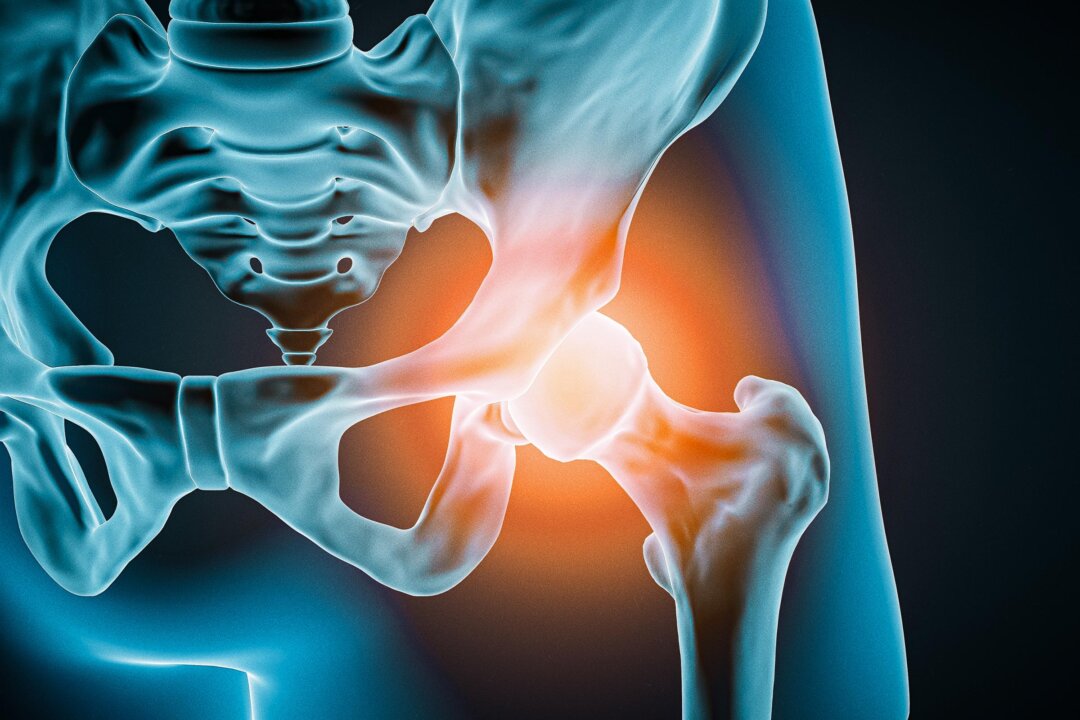At 45, Jackie Curran couldn’t sit through a meeting or sleep through the night. A lifelong athlete, she chalked up the pain to overtraining, or maybe a back issue. For nearly a decade after her back first started showing pain, she powered through high-intensity interval training classes and long runs, unaware that the real problem was in her hip.
“I couldn’t even stand up straight. I thought it was my back. But when they did X-rays and said, ‘Your back is fine—it’s your hip. You need a replacement.’ I started crying,” she told The Epoch Times. “I didn’t understand how that could be true.”
Curran didn’t think she fit the image she had of a hip replacement patient—she was still in her 40s and had so much muscle tone. By the time she saw a surgeon, the joint damage was significant. It took nearly six months of physical therapy to return to full strength.
By contrast, Jim O’Neal, at 80, recognized the signs. “I knew I wasn’t getting any younger,” he told The Epoch Times. “I had a dull ache that wouldn’t go away, and my brother had just had his hip replaced.”
It wasn’t too long after surgery before O’Neal was back to his nine-hole golf game.
“I don’t even notice I had it done.”
Curran and O’Neal both experienced the same initial issue. However, the direction their paths took reflects how age, lifestyle, and expectations shape the hip replacement experience.
When Conservative Care Works
Not every ache or limitation means surgery is inevitable. Many people find relief through conservative initial approaches such as physical therapy, using a cane, medication, or even simple changes to how they sit or move throughout the day.
“When I see a patient, they’re at the intersection of biology and behavior,” Smita Rao, a physical therapist and professor at New York University, told The Epoch Times. Some people are more prone to hip issues because of bone structure or tissue inflammation—those are the non-modifiable factors. However, many contributors, such as posture, core weakness, and limited hip mobility, can be improved.
“If someone responds well to those changes over six to twelve weeks, surgery may never be needed,” Rao said. “But if there’s little or no improvement, that often tells us structural damage is playing a bigger role. That’s when we refer them to a surgeon.”
When It’s Time to Consider Surgery
If conservative care stalls or stops helping, the decision to have surgery becomes more about quality of life than X-ray results.
“Surgery usually comes into the conversation when someone says, ‘I can live with it—I just don’t want to anymore,’” Dr. Matthew Beal, an orthopedic surgeon at Ohio State University Wexner Medical Center, told The Epoch Times. “My job is to assess the joint, but also to understand where the patient is emotionally and functionally with the decision.”
People tend to reach that decision for different reasons—ongoing pain, loss of sleep, slowing down, or just not being able to do the things they love. For Curran, beyond pain relief, it was about keeping up with her four kids. For O’Neal, it was a trip across the country to celebrate his 81st birthday with his grandkids.
While hip replacement isn’t usually urgent, waiting too long does have risks. “People change the way they walk to compensate,” Beal said. “That can overload the knees, back, or even the other hip.” More severe joint damage can also make the surgery more complex and recovery slower.
Still, Beal said that the decision isn’t about rushing into the operating room. If you’ve tried the right non-surgical approaches, but your world is getting smaller, that’s when it may be time to reconsider.
Modern Hip Replacement
Today, total hip replacement is often an outpatient procedure, and many people go home the same day if they’re healthy, have support at home, and are sufficiently mobile.
Most implants are made from metal, polyethylene, or ceramic. While serious complications are rare, no implant lasts forever—especially for younger, more active patients who may need a revision later in life.
“The younger you are, the more likely you’ll need a revision [to replace worn-out parts],” according to Beal. “It’s really about activity—patients in their 30s or 40s tend to put more wear on an implant than someone in their 60s.”
Patients over 55—especially those in their 60s and beyond—can expect their implants to last at least 15 to 20 years.
What Recovery Looks Like
The recovery experience after hip replacement isn’t one-size-fits-all—and it’s often shaped by what comes before the surgery.
Curran was young and strong when she had her hip replaced, but that didn’t make recovery easier, in her situation, it made it harder.
Unbeknownst to her, she had likely been eligible for a replacement since her mid-30s. Instead, she spent nearly a decade pushing through the pain. By the time she had surgery, the muscles around her joint had been overcompensating for so long that her alignment was off, and everything had to be retrained once the new hip was in place.
Although her surgeon used the anterior approach, often associated with faster recovery, Curran’s healing still stretched to six months, placing her on the longer end of the typical recovery range.
“I wasn’t prepared for how much PT [physical therapy] and rehab it would take,” she said. “I just expected it to be as strong as it ever was, and good to go.”
She dealt with swelling, muscle weakness, and unexpected pain—not in the joint itself—but in the soft tissue surrounding her new joint. “It wasn’t joint pain. It was everything around it—my IT [Iliotibial] band, my quad, my glutes … everything had to be retrained.”
Active people can experience slower recoveries, in part because there’s more muscle to rebuild and more soft tissue disrupted during surgery. They also tend to expect more from their bodies—and how quickly they’ll bounce back.
For Curran, physical therapy made all the difference. It wasn’t just about strength—it helped her rebuild from the inside out, correcting years of imbalance.
“PT saved both my mental and physical health,” she said. “Good PT is worth its weight in gold.”
Eight years later, she’s grateful. “I do everything now—yoga, weight training, hiking, biking. I don’t run anymore, but that’s a choice. My life is full again.”
In contrast, some older people, especially those who are less active beforehand, may actually have a smoother recovery, in part because they have less muscle mass to rebuild and put less demand on the new joint. They also often get quick relief from the arthritic pain that led them to surgery in the first place.
That was the case for O’Neal. He also had anterior surgery—but was walking across the house the day after surgery.
“I used a walker for one day. It was a piece of cake,” he said. “I haven’t felt pain since.”
Hip Pain: What to Try First
“To us, 50 is young. Sixty is young,” Rao said. “Hip care today is about supporting that—so people can keep doing what they love.”
When it comes to hip pain, the right care plan often starts with the right questions: Is your pain limiting your daily life or sleep? Have conservative treatments made a difference? Are you avoiding activities—and at what cost?
If you’re not sure what your pain means—or what to do next—here are a few first steps to consider:
- Start With Physical Therapy: A physical therapist can assess how you move, what muscles are weak, and whether posture, strength, or movement mechanics are contributing to your pain.
- Adjust Daily Activities: Sometimes small changes—how you sit, stand, or exercise—can significantly reduce discomfort.
- Use Movement as a Test: If symptoms improve over six to 12 weeks with conservative care, surgery may never be needed. If they don’t improve, imaging can help clarify what’s going on structurally.
- Watch for Compensation Pain: Discomfort in your back, knee, or opposite hip may signal that you’re adjusting your gait—potentially creating new problems over time.
- Have the Conversation Early: Even if you’re not ready for surgery, it’s helpful to start building a care plan with your doctor or surgeon.
- Listen to Real Stories: Talk to others about what recovery was like, what surprised them, and what they wish they’d known. Their stories can give you a clearer picture—and a little peace of mind.
“It wasn’t just the athlete in me that needed surgery—it was the person in me,” Curran added. Before her surgery, she told her doctor, “I can still do everything I want—I just hurt the other 23 hours of the day.”
Understanding that was what finally made her decision clear.



